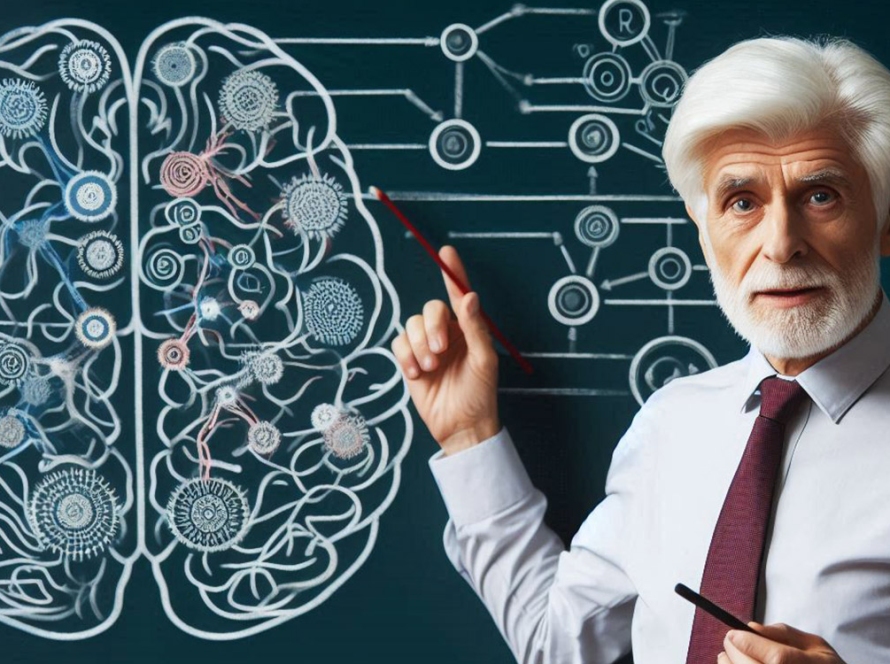Traumatic brain injury affect learning in various ways, impacting cognitive functions and educational outcomes. Traumatic brain injury (TBI) is caused by an external physical force and results in disruption of brain function or other evidence of brain pathology. The global incidence of TBI is estimated at 50 million cases annually, with higher rates of morbidity and mortality observed in low-income and middle-income countries. TBI costs the global economy approximately 400 billion US dollars annually, accounting for 0.5% of the gross world product. Traumatic brain injury affects learning, cognitive ability, memory, problem-solving skills, communication, and attention. Depending on the affected area of the brain, they may experience challenges expressing their thoughts verbally and in writing. Traumatic brain injury, whether mild, moderate, or severe, can lead to significant changes in everyday life. studies focus on TBI effects on learning among children in various educational settings. Students with Traumatic brain injury may encounter various physical or sensory disabilities that can significantly affect their academic performance upon returning to school.
Table of Contents
What is a traumatic brain injury (TBI)?
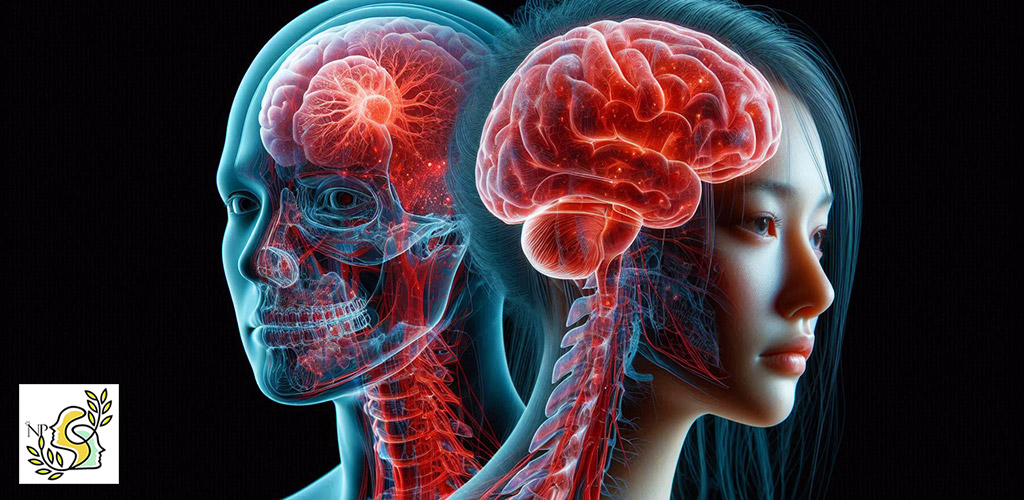
what is traumatic brain injury? Traumatic brain injury (TBI) can result from a bump, blow, or jolt to the head, or a penetrating head injury that disrupts the brain’s normal function. There are two types of traumatic impact injuries: closed (nonpenetrating) and open (penetrating). TBI can manifest in various forms, from mild alterations of consciousness to an unrelenting comatose state and death. In the most severe cases, the entire brain is affected by a diffuse type of injury and swelling. Mild injuries likely make up more than 80% of all TBIs, although the true incidence is hard to determine because many patients who sustain these injuries do not seek medical attention, and therefore, their cases are not documented or tracked. Traumatic injuries disrupt normal cellular function within the brain through direct, rotational, and shear forces, which can be present in all severities of injury. Traumatic brain injury affects learning, cognitive ability, memory, problem-solving skills, communication, and attention. Depending on the affected area of the brain, they may experience challenges expressing their thoughts verbally and in writing.
One of the best and most complete podcasts you can hear in the field of tbi is the Living with TBI (Traumatic Brain Injury) podcast by Dr. Jeff Gould, the founder of the tbicoaches.com which you can listen to the first episode of here.
Signs and symptoms of traumatic brain injury
Traumatic brain injury (TBI) can result in a wide range of symptoms, as the specific deficits depend on the area of the brain affected and the severity of the injury. The Glasgow Coma Scale (GCS) score, duration of unconsciousness, and post-traumatic amnesia are used to determine the severity of symptoms.
The signs and symptoms of mild traumatic brain injury may include:
- Physical symptoms
- Headache
- Nausea or vomiting
- Fatigue or drowsiness
- Problems with speech
- Dizziness or loss of balance
People who have experienced repetitive traumatic brain injury tend to report more cognitive problems and symptoms of depression compared to those who have not had a traumatic brain injury. The most common cognitive complaints include difficulty remembering the names and faces of new people, relying on notes or reminders to remember things, and feeling like others would say their memory has worsened.
Common symptoms of depression reported include changes in sleep patterns and appetite, as well as tiredness or fatigue. It’s important to note that fatigue in the acute stage has been identified as a risk factor for long-term cognitive and behavioral symptoms. Weaknesses in executive function were found in both metacognitive and behavioral functions. The findings suggest that accumulating traumatic brain injuries over a lifetime can lead to subtle changes in mood and cognitive symptoms, even in individuals who are highly functioning.
Traumatic brain injury affects learning. People who have suffered a traumatic brain injury (TBI) may encounter difficulties with learning and memory. Many students face challenges due to learning disabilities and traumatic brain injury, which can affect their academic performance.
In this regard, I suggest you watch the additional video below.
How does traumatic brain injury affect learning?
Many individuals face challenges in learning after traumatic brain injury (TBI). A traumatic brain injury’s potential effect on learning can vary widely, often impacting memory, attention, and cognitive processing abilities. Traumatic brain injury affects learning whether mild, moderate, or severe that significantly changes in everyday life. It can affect a person’s ability to take care of themselves and others, participate in productive activities, and engage in personal and social roles. Deficient learning and memory are frequently reported as a consequence of traumatic brain injury (TBI).
Working memory (WM), the ability to monitor, process and maintain task relevant information on-line to respond to immediate environmental demands, is controlled by frontal systems which are particularly vulnerable to damage from a traumatic brain injury (TBI). Researches focuses on understanding traumatic brain injury effects on learning and cognitive development in young adults.
Based on a combination of incidental and experimental observations, robust evidence supports the dissociation of learning into explicit (declarative) learning and implicit (non-declarative) learning.
Explicit (declarative) learning is the process of consciously encoding, consolidating, storing and retrieving factual knowledge. Explicit learning may include learning new words, concepts, and their meaning (sematic learning), or committing details of an event or location to memory (episodic learning).
Implicit (non-declarative) learning is the process of unconsciously acquiring or modifying behavior through experience. Implicit learning may include developing a conditioned response to a specified stimulus (associative learning), developing a sensitization or habituation in response to a specified stimulus (non-associative learning), or learning a new skill (procedural learning).
Focal trauma to the head often results in contusions to the anterior and lateral surfaces of the brain – incorporating damage to the dorsolateral prefrontal cortex and the medial temporal lobe (and underlying subcortical structures, in the cases of severe injury).
Given the mechanisms that cause traumatic brain injury, and the anatomical location of structures critical to learning, explicit learning may be more vulnerable to injury than implicit learning, particularly after focal injury. Given that implicit learning is generally less impaired than explicit learning after traumatic brain injury, some have argued that training approaches that emphasize implicit learning after traumatic brain injury may be preferable to training approaches that emphasize explicit learning.
Students with traumatic brain injury (TBI)

Traumatic brain injury (TBI) is a significant cause of death and disability in the American population. However, its impact on the school experience of high school and post-secondary students is not well understood. The traumatic brain injury impact on learning can vary greatly, affecting cognitive abilities, memory, and concentration skills. Studies show schooling is impacted by a TBI and identify the most common self-reported issues students face when returning to school.
Symptoms of TBI in students
Traumatic Brain Injury can affect students’ learning in various significant ways.
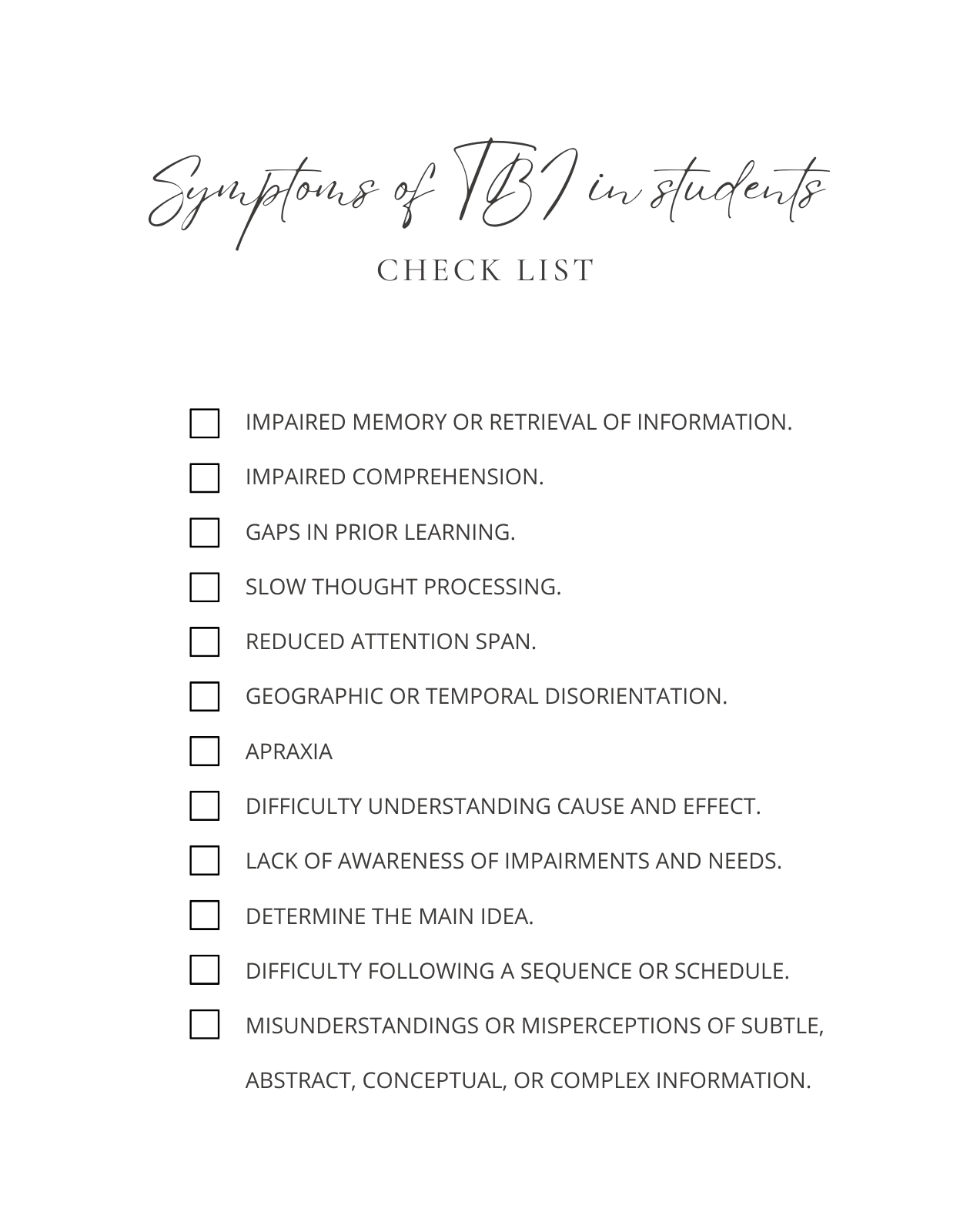
Cognitive impairments resulting from traumatic brain injury are the most significant and often the hardest to recognize—a fact that can confound a student’s adjustment to postsecondary life and learning. A student with a brain injury may experience some or all of the following cognitive impairments:
• Impaired memory or retrieval of information.
• Impaired comprehension.
• Gaps in prior learning.
• Slow thought processing.
• Reduced attention span.
• Geographic or temporal disorientation.
• Apraxia (total or partial memory loss of how to perform complex muscular movements).
• Difficulty understanding cause and effect.
• Lack of awareness of impairments and needs.
• Inability to prioritize thoughts or determine the main idea.
• Difficulty following a sequence or schedule.
• Misunderstandings or misperceptions of subtle, abstract, conceptual, or complex information.
Traumatic Brain Injury can affect Students’ learning
A traumatic brain injury learning disability, affecting cognitive and academic performance. After experiencing a brain injury, an individual may lose prior knowledge of important concepts. For instance, a student might continue to receive good grades in high school after a brain injury, but may not remember basic math or history facts learned in earlier grades. Additionally, a brain injury can impair the student’s ability to retrieve information when needed, even if the student otherwise remembers the information.
The researches focus on the traumatic brain injury effect on learning outcomes in students. Many students with brain injuries often encounter difficulty expressing their thoughts in writing or speech. A brain injury can alter a person’s entire cognitive process. Relearning to think following a brain injury is like transitioning to a manual shift car after a lifetime of driving an automatic: tasks once considered easy become tiring and frustrating.
A student’s learning habits before the injury can have a positive or negative impact on future learning. Those with good study skills, who completed work legibly and on time and communicated well with teachers before their injury, will benefit from these habits afterward. Those who learned easily with minimal studying may have difficulty accepting, understanding, or even remembering that learning is now slower, or that they need help with tasks they once managed independently. Students who were average or even exceptional before their injury may struggle to succeed when applying their prior level of effort.
TBI Treatment
The treatments for TBI depend on many factors, including the size, severity, and location of the brain injury.
What is behavior learning for traumatic brain injury?
Behavior learning for traumatic brain injury (TBI) refers to the process of teaching individuals with TBI new skills and adaptive behaviors to help them regain independence and improve their quality of life. This approach often involves structured rehabilitation programs that utilize principles of behavioral therapy, cognitive rehabilitation, and skill acquisition techniques. Therapists may employ strategies such as reinforcement, modeling, and practice to encourage positive behavioral changes and teach coping mechanisms for challenges related to memory, attention, and executive functioning. By focusing on behavior modification and learning, individuals with TBI can better navigate daily activities, manage social interactions, and enhance their overall well-being.
Clinical neuropsychology is a specialized field that studies the relationship between brain function and behavior. Practitioners in this field conduct assessments to diagnose various disorders, including traumatic brain injuries, strokes, and neurodegenerative diseases. Through a combination of psychological testing and neuroimaging techniques, clinical neuropsychologists strive to understand individual differences in cognitive functioning and to develop tailored interventions that enhance patients’ quality of life.
There are treatments for traumatic brain injury (TBI)
- Anti-anxiety medication to lessen feelings of nervousness and fear.
- Anticoagulants to prevent blood clots.
- Anticonvulsants to prevent seizures.
- Antidepressants to treat symptoms of depression and mood instability.
- Muscle relaxants to reduce muscle spasms.
Learning to walk again after traumatic brain injury
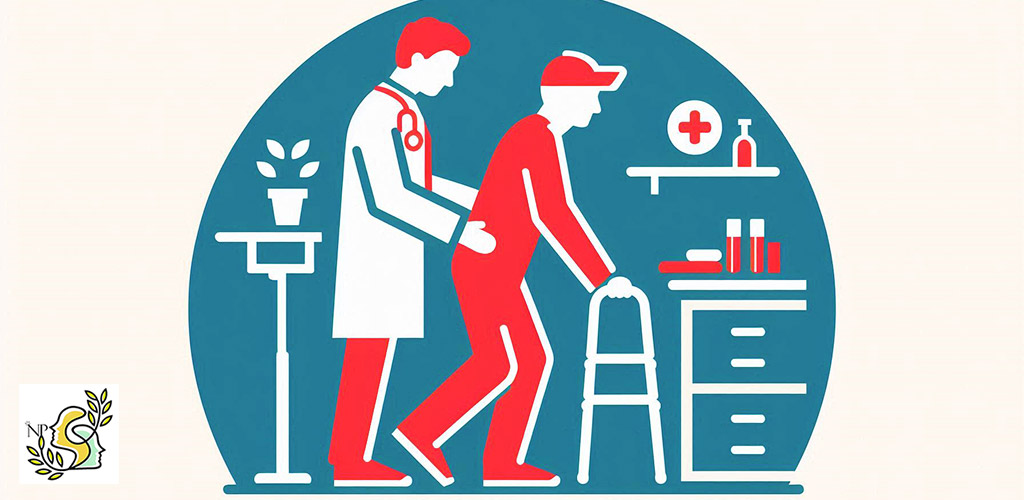
Many researchers focus on learning after traumatic brain injury to improve rehabilitation strategies. Learning to walk again after a traumatic brain injury requires the use of many muscles and involves precise movements. Around 60% of traumatic brain injury patients can walk again after six months. After one year, speech and cognitive abilities typically show significant improvement. Some balance issues can be effectively treated in one or two sessions, while others may require weeks, months, or even years.
Relearning to walk after a brain injury can be a challenging but ultimately rewarding experience. Consistent practice of rehabilitative exercises is crucial for rewiring the brain and regaining walking ability. The specific exercises for walking after a traumatic brain injury vary from person to person. Physical therapy provides several benefits for individuals relearning to walk after a traumatic brain injury. A trained therapist can guide individuals through exercises to enhance muscle strength, tone, and balance.
Alternative treatments for traumatic brain injury
The Effects of TBI on Learning and Memory have been extensively studied in recent years. It is crucial to find effective therapies to assist in the recovery and ongoing rehabilitation of the approximately 50-60 million people worldwide who suffer from a traumatic brain injury (TBI) each year. While many traditional therapies are available for people with a traumatic brain injury, some lesser-known therapies have been proven to yield incredible results.
Here are five therapies used by people with TBI that offer numerous advantages and benefits:
- Animal Assisted Therapy (AAT)
- Music therapy
- Art therapy
- Video games
- Hydrotherapy
Other therapies for TBI
There are other therapies for TBI:
Exercise
Physical exercise that promotes cerebrovascular health, such as running, biking, or swimming, is crucial for aiding recovery. These activities improve the brain’s glymphatic system, which helps clear toxic proteins and also reduces pain sensitivity. Starting a cerebrovascular-promoting exercise routine as soon as patients are clinically stable is highly beneficial and has been shown to significantly reduce the need for opiates in traumatic brain injury patients.
Eastern medicine
Eastern medicine offers beneficial options for the long-term management of Traumatic Brain Injury (TBI). Acupressure and acupuncture can help with stress management and pain reduction. Studies have shown that yoga can improve mental functioning. While the evidence for tai chi and qi gong is less convincing, further investigation is warranted. Mindfulness cognitive-based therapy is the most well-studied intervention and has a positive effect on self-esteem and mental clarity.
These complementary approaches should be used as supplements to the medications, not as stand-alone treatments. They should also not replace regular and sustained cerebrovascular-promoting exercise.
How can schools support students with TBI?
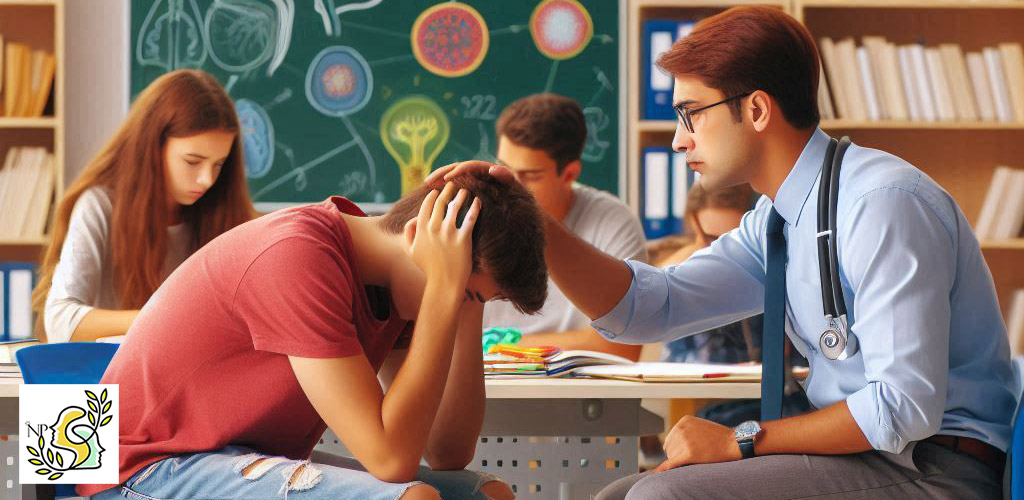
Many students face learning and memory difficulties that can affect their academic performance. Students who have suffered a traumatic brain injury (TBI) may face cognitive, psychosocial, and physical challenges that can significantly affect their academic performance upon returning to school. To ensure a successful transition back to education for these students, it is crucial to thoroughly assess their individual needs and abilities, and then implement specific classroom interventions to address those needs. Students with TBI often need extra time to process information, complete tasks, and respond to verbal cues and questions from teachers. Here are some strategies that schools can use to support students with traumatic brain injuries:
1. Provide external devices and cues to help students compensate for organization, memory, and motor deficits.
2. Customize academic programming and scheduling to fit the changing needs of children. Flexibility is key.
3. Structuring the school environment can help manage antecedents or consequences contributing to problem behaviors and prevent such behaviors from occurring.
4. Pay special attention to the physical arrangement and structure of the classroom to facilitate mobility and accommodate physical needs. For example, a student with poor mobility may require assistance to participate in typical classroom activities.
5. Create a predictable and consistent routine within the classroom. Consider the length of the school day that students can tolerate, their nutritional needs, and their fatigue levels, as well as their need for rest breaks.
6. Modify existing materials to assist students with TBI in learning and functioning in the classroom setting. Examples of alterations include providing carbon paper notes, large print books, books on tape, and graphic organizers (visual displays to organize information).
7. School districts have various options and resources to accommodate the learning needs of students returning to school following a TBI. Individualized planning is crucial due to the extreme variability in outcomes following brain injury.
8. Use teaching strategies that are effective for students with different types of learning difficulties. These strategies can also be useful for students with brain injury.
9. Provide specific training in self-management or self-monitoring strategies. Self-management involves teaching students to evaluate and monitor their behavior and performance.
10. Implement programs designed to improve social skills in the school setting. These programs should include teaching specific skills (e.g., initiation, topic maintenance, turn-taking, active listening), repeated practice, constructive feedback, and opportunities to practice in the natural setting with peers, staff, and parents.
Traumatic brain injury and substance abuse treatment
Traumatic brain injury (TBI) is a leading cause of death and disability worldwide. Accidents are a major cause of brain injury, and many accidents are alcohol or drug-related.
Evidence indicates that a vast majority of victims with traumatic brain injury test positive for alcohol or illicit drugs at the time of hospital admission. Studies shows that alcohol intoxication was present in one-third to one-half of hospitalizations. Nearly two-thirds of rehabilitation patients may have a history of substance abuse that preceded their injuries. Intoxication is related to acute complications, longer hospital stays, and poorer discharge status.
Frequently, individuals with traumatic brain injury struggle to succeed in traditional drug and alcohol treatment programs because these programs do not consider their cognitive impairments and learning styles. Treatment programs that understand the typical behaviors associated with traumatic brain injury are more effective in treating individuals dealing with both traumatic brain injury and substance abuse issues.
Conclusion
Research indicates that traumatic brain injury affect learning in various ways. Individuals with TBI may experience various cognitive deficits, such as difficulties with attention, memory, processing speed, and executive functions. These challenges can hinder their ability to acquire and retain new information, leading to academic struggles, decreased motivation, and emotional difficulties, which further complicate the learning process. TBI effects on learning can significantly impact a student’s academic performance and social interactions. Early intervention, tailored educational strategies, and supportive environments are essential for helping individuals with TBI navigate their learning challenges and reach their full potential. By understanding the complexities of TBI and its effects on learning, educators and caregivers can foster resilience and create more effective support systems for those affected.
Frequently Asked Questions
Here is Frequently Asked Questions about traumatic brain injury:
Can a traumatic brain injury cause schizophrenia?
individuals who experience a brain injury may be at a higher risk for developing schizophrenia, particularly if they have a genetic predisposition to the disorder.
Can a stroke cause traumatic brain injury?
A stroke is classified as a Non-Traumatic Brain Injury (nTBI) because it results from internal factors rather than external ones. Therefore, a stroke itself cannot cause a traumatic brain injury.
Is a stroke a traumatic brain injury?
Stroke is considered a Non-Traumatic Brain Injury (nTBI) because it originates from internal factors. Traumatic Brain Injury (TBI) is directly caused by a blow to the head.


